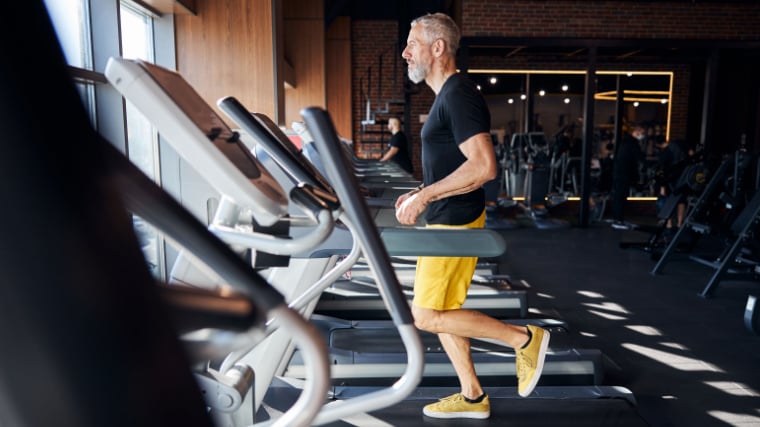Many people who exercise tend to label themselves “lifters” because, well, they lift weights in the gym. However, what some people (conveniently?) overlook is that there’s a whole other world of exercise available to them — cardio training. While the thought of treadmills, ellipticals, recumbent bikes, and assorted machinery might trigger waves of muscle-burning trepidation, cardio workouts can…
The post 10 Benefits of Cardio: Build Your Physique, Health, Performance, and More appeared first on Breaking Muscle.
Many people who exercise tend to label themselves “lifters” because, well, they lift weights in the gym. However, what some people (conveniently?) overlook is that there’s a whole other world of exercise available to them — cardio training.
While the thought of treadmills, ellipticals, recumbent bikes, and assorted machinery might trigger waves of muscle-burning trepidation, cardio workouts can be as simple as going for a walk outside. Yep, something people learned to do before they could talk can still be considered exercise if it’s programmed properly.

Here’s a closer look at some research-based reasons why you should consider being more than just “a lifter.”
Benefits of Cardio
- Aerobic vs. Anaerobic
- Physical Benefits
- Performance Benefits
- Unexpected Benefits
- Frequently Asked Questions
Aerobic Cardio vs. Anaerobic Cardio
Cardiovascular exercise, in general, can be performed one of two ways: aerobically or anaerobically. Their benefits overlap in some respects while also delivering distinct advantages from each other. (1) The key difference is their inherent training intensities, or speed of movement, and the stimuli they trigger in the body. For clarity throughout this article, aerobic training will be the primary cardio method discussed in each subsequent point.
Aerobic cardio is likely what most people imagine when they hear the phrase “cardio training.” Aerobic training is performed at a low to moderate intensity, such as walking or jogging. The relatively low intensity allows the body to continue the exercise for a relatively long duration.
For example, Olympic race walking (yes, that’s a thing) has had races up to 50 kilometers (31 miles) with athletes moving non-stop for more than four hours. This potential for longer sessions is why aerobic work is often synonymous with “endurance training.”
Anaerobic training is most notable for being relatively high intensity and short duration. The body cannot perform anaerobic training for an extended time because the heart rate is extremely elevated and the metabolic processes needed to fuel muscle contractions are short-lived. It’s like asking a car to drive 100 miles per hour while the low fuel light is on — neither smart nor safe.

Anaerobic exercise is typified by high-intensity interval training (HIIT), sprinting, many “metcon” (metabolic conditioning) workouts, and any fast-paced movements that cannot be maintained for more than a few minutes, or even several seconds, without rest. A heavy set of three deadlifts or a set of 50 kettlebell swings, for example, are also cases of anaerobic exercise.
Boost Your Health with Cardio
Cardio exercise can be for more than just burning some extra calories or warming up before grabbing a barbell. As a reminder, “cardio” is actually short for cardiovascular, as in, your cardiovascular system which pumps blood throughout your entire body. Cardio training can have several significant health benefits, regardless of your goals in the gym.
Cardiovascular Health
This may seem like a statement that should go without saying, but cardiovascular training can improve your cardiovascular health. Just like biceps training can improve your biceps or lower body training can improve your leg strength, training your cardiovascular system can strengthen and improve your cardiovascular function.
A stronger heart and better total-body circulation can improve cholesterol levels and blood pressure while decreasing the risk of potentially deadly cardiac events like stroke or heart attack. (2) Cardiovascular exercise is also associated with decreased total-body inflammation, which can further decrease the risk of cardiovascular disease. (3)
While not directly related to cardiovascular health, performing low to moderate intensity cardio exercise after eating, especially after your largest meal of the day, has been associated with decreased blood sugar levels. (4) This can be an effective approach for people living with diabetes or prediabetes.
Reduced Joint Pain
For those dealing with joint pain, whether it’s from overuse in the gym or the onset of diagnosed arthritis, aerobic training has been shown to decrease pain and improve functional use of affected joints, particularly in the lower body (hips, knees, and ankles). (5)(6)

Walking with knee pain may sound counterproductive, but a structured plan that carefully monitors intensity, duration, and frequency may improve symptoms and joint function. You certainly wouldn’t want to log miles while hobbling in agony, but a gradual approach performed with a deliberate and cautious approach could be incorporated into your general training plan.
Similarly, moderate cardio training has been shown to stimulate bone density and potentially slow down the effects of osteoporosis. (7) This can be an ideal complement (or alternative) to weight training, which can also provide bone-strengthening similar results.
Improved Immune System
If you’ve ever been told to “go out and get some fresh air” after complaining about feeling poorly, it turns out you received some practical and science-based advice. Aerobic exercise, though not specifically outdoor exercise, has been shown to support a healthy immune system. (8)
Exercising while sick is an often debated point, but regular exercise (including cardio training) performed consistently may help improve your overall immune function. This could give you a headstart in fighting common colds or even certain viral infections. (9)
While exercise certainly can’t create a full-on immunity to any particular sickness, cardio exercise may stimulate an antibody response that supports your body’s natural immune system. Over the long-term, this type of “cellular reinforcement” may have a cumulative effect to put you in the most advantageous position to fend off common illnesses, especially when supported by a nutritious diet.
Cardio for Better Gains
For better or worse, some lifters are primarily interested in using cardio as a tool to support their efforts in the gym. Whether your priority is lifting heavier weights, building more muscle, or burning more fat, cardio workouts can be used in a performance-boosting context. Here’s why a bit of cardio can help, not hinder, your lifting.
Increased Fat Loss
Arguably the most common reason a lifter would decide to hop on a piece of cardio equipment — to burn some extra calories — cardio can be a highly effective part of a fat loss routine.
While a goal-focused diet plan is necessary for fat loss, and a proper weight training program is necessary to build and preserve muscle mass, cardio exercise can be a game changer for reshaping your physique and getting lean. (10)
Interestingly, and perhaps counterintuitively, some research has actually shown a degree of fat loss from only performing aerobic exercise, without a coordinated diet or weight training plan. (11) While this approach may not be ideal in terms of overall body composition and lean muscle mass, it raises an interesting potential as a “starting point” for anyone looking to lose body fat without necessarily being able to follow a comprehensive weight training program.
If you’re looking for fat loss, you could make some strides toward progress if you did nothing other than following a basic cardio training plan. Adding a tailored nutrition plan and structured weight training routine will support those efforts even further.
Improved Recovery
If there’s one secret weapon any lifter can deploy to boost recovery between sessions and enter each workout at maximum capacity, it would be turning some of your weekly rest days into active recovery days.
“Passive recovery” is the technical term for carrying on your standard, non-exercise activities on days you’re not training — your typical rest day. Performing low intensity exercise is considered to be active recovery because you’re actively/deliberately moving your body, encouraging blood flow, and decreasing residual muscle soreness. (12)(13)

Although you could perform any type of relatively low intensity exercise as an active recovery workout — low volume/low intensity weight training, group fitness class, pickup basketball game, etc. — those forms of activity can require a bit more forethought and planning to ensure they provide the intended recovery benefits without creating excessive fatigue.
Instead, an effective “no-brainer” active recovery workout can be as simple and practical as taking a relatively long, easy-paced walk or bike ride. For an active recovery workout to provide the most benefit, it shouldn’t feel like a workout when you’re doing it.
Increased Endurance and Conditioning
Second to fat loss goals, long duration endurance-type training is what many people in the gym associate with cardio sessions. Logging mile after mile on the treadmill or bike is one way to spend your time in the gym, and it might actually pay off if that’s what you’re after.
Not only can this type of “sport-specific” endurance training help if your goal is to eventually tackle a 26.1-mile marathon, but overall aerobic fitness can improve your overall conditioning. This can help to bounce back between weight lifting sessions, and even potentially recover quicker between sets of intense weight training. (14)(15)
Maybe you’re a competitive powerlifter who attends a meet where your first squat attempt is at 11 a.m. and your last deadlift ends up being at 7 p.m. Or maybe you’re a bodybuilder taking the stage to pose for callout after callout. Or it could just be that your typical back workout leaves you so winded, you end up resting on a comfy incline bench waiting to catch your breath enough to make it into the locker room.
In any of those cases, boosting your general conditioning with some strategic cardio training could raise your base level of general fitness to the point where it’s not holding back your overall performance.
Muscle Growth
Many people believe that lifting is good for muscle growth and cardio is good for almost everything except muscle growth. That’s generally true. However, some research has shown a modest muscle-building stimulus from relatively lower intensity aerobic exercise, particularly in the legs. (16)(17)
This can be especially useful for people who may not be able to perform resistance training due to an existing injury. It’s also a potential solution for people with limited energy levels, or mobility restrictions, which can limit their overall exercise options.
Higher intensity anaerobic training has also been shown to trigger muscle growth in the involved muscle groups. However, higher intensity training requires more finely tuned programming to avoid interfering with a concurrent weight training routine. The higher intensity would not be an efficient or practical choice for people recovering from injury or dealing with low energy issues (for example, elderly people unaccustomed to regular exercise).
Surprising Cardio Benefits
Beyond the direct physical benefits, there are some unanticipated but equally significant reasons to make cardio exercise a regular part of your training week.
Improved Mental Health
“Clearing your head” with a good workout doesn’t have to mean loading up the bench press and repping out or putting on some boxing gloves and hitting a heavy bag. Grabbing a cardio workout can be just as effective for improving mental clarity, decreasing symptoms of depression, reducing anxiety, and improving mood. (18)(19)(20)

Next time you feel like taking a break from the stress of the tough day, head out for a quick walk and listen to five of your favorite songs or an entire Ramones album, whichever is shorter. When the music’s done, turn around and repeat it on the walk back.
Many experienced lifters have relied on “iron therapy” in the gym, lifting weights for a mental boost that matches the physical. Experienced cardio practitioners have also found their own parallel, often described as a “runner’s high.”
In both cases, physical activity was seen to have a distinct and noticeable effect on their overall mental health. It’s not often the reason a person begins exercising, but this benefit can sometimes become a welcomed and necessary reason to continue training.
Better Sleep Quality
Exercise and sleep have a symbiotic relationship. When you get a good night’s sleep, you wake with more energy and you can tackle a tough workout. Whenever you have a good, productive workout, you’re typically able to get a good night’s sleep (from fatigue or a simple sense of accomplishment).
Cardio exercise has been directly associated with improved sleep quality (the level of restoration a given night’s sleep actually provides). (21)(22) A high degree of sleep quality is associated with healthy hormone levels, improved immune system function, increased muscle mass, and improved overall athletic performance.
However, some lifters may inadvertently sabotage their sleep schedule by taking highly caffeinated pre-workouts late in the day. Paying attention to your supplement ingredients and timing, and avoiding stimulants within several hours of going to sleep, can put you in a better position to actually sleep well.
Exercise timing hasn’t shown a variety of influences, with training sessions either in the morning or 90 minutes before bed both helping to improve sleep quality. The key is to get the exercise done when your schedule allows. Your individual preference and response are certainly a factor, as well. You’ll know whether a treadmill run will amp you up and re-energize you or if it helps to drain your battery as you slide into slumberland.
Accessible to Everyone
There aren’t too many forms of exercise that can be simultaneously performed by a mother pushing a set of twins in a jogging stroller, her husband the competitive weightlifter, and her mother the 75-year old retiree with a bad hip — but basic cardio exercise is one.
Going for a walk can be a simple, barebones, effective workout that doesn’t require any specialized equipment or gym membership. Cardio is accessible to everyone: experienced gym-goers and beginners, young athletes and older adults.
While you don’t need a gym membership to perform basic body weight resistance exercises like push-ups or lunges, you also don’t need a gym membership to walk, run, or perform body weight cardio exercises like burpees (which have a love ’em or hate ’em reputation). Cardio can be done virtually anywhere, almost anytime, by almost anyone.
FAQs
Yes and no. “Exercise” is an all-encompassing term that could cover anything from walking a 20-minute mile to taking a yoga class to lifting a 300-pound front squat.
It’s absolutely true that exercise, in general, can provide some of the benefits discussed above. For example, using a combination of both weight training and cardio training has been shown in some research to promote better cardiovascular health than using only one method or the other. (23)
However, weight training programs can require more specific attention to programming and progression than cardio. Manipulating weights, sets, and reps can be more challenging and can involve more planning than going for a walk or taking a bike ride.
There are also some physical capacities that cannot be built without longer duration cardio exercise. Just ask any pro fighter who’s ever gassed out in round four or any strength athlete who’s needed an oxygen mask between lifting attempts.
For the best overall improvements in your health, physique, and overall performance, find ways to follow a well-designed, goal-focused plan that incorporates resistance training and cardio exercise on a regular basis.
The details will largely depend on your specific workout split (how many days you’re currently training), as well as your specific goal.
In general, adding two or three cardio sessions per week can be a good place to start. Begin with 15 to 20 minutes of low to moderate intensity work, either on a non-training day or performed immediately after your weight training.
Avoid performing significant cardio training before a lifting session, which may negatively affect strength output for the resistance training to follow. (24) A brief warm-up is fine, but don’t let five to 10 minutes on the bike turn into a full-blown 45-minute cardio workout.
Hop Aboard the Cardio Train
Regardless of your specific training goal, cardiovascular exercise can deliver a slew of benefits for relatively little time investment. Relatively low intensity cardio can require minimal adjustment to your current training plan. As training intensity increases, so does the need to more carefully balance the big picture program. Don’t buy the hype that’s sometimes peddled: “Cardio burns muscle. All you need is lifting.” That’s a short-sighted outlook that will only prevent you from maximizing your health, physique, and performance.
References
- Patel, H., Alkhawam, H., Madanieh, R., Shah, N., Kosmas, C. E., & Vittorio, T. J. (2017). Aerobic vs anaerobic exercise training effects on the cardiovascular system. World journal of cardiology, 9(2), 134–138. https://doi.org/10.4330/wjc.v9.i2.134
- Pinckard, K., Baskin, K. K., & Stanford, K. I. (2019). Effects of Exercise to Improve Cardiovascular Health. Frontiers in cardiovascular medicine, 6, 69. https://doi.org/10.3389/fcvm.2019.00069
- Zheng, G., Qiu, P., Xia, R., Lin, H., Ye, B., Tao, J., & Chen, L. (2019). Effect of Aerobic Exercise on Inflammatory Markers in Healthy Middle-Aged and Older Adults: A Systematic Review and Meta-Analysis of Randomized Controlled Trials. Frontiers in aging neuroscience, 11, 98. https://doi.org/10.3389/fnagi.2019.00098
- Borror, A., Zieff, G., Battaglini, C., & Stoner, L. (2018). The Effects of Postprandial Exercise on Glucose Control in Individuals with Type 2 Diabetes: A Systematic Review. Sports medicine (Auckland, N.Z.), 48(6), 1479–1491. https://doi.org/10.1007/s40279-018-0864-x
- Roddy E, Zhang W, Doherty MAerobic walking or strengthening exercise for osteoarthritis of the knee? A systematic reviewAnnals of the Rheumatic Diseases 2005;64:544-548.
- Rahnama, N., & Mazloum, V. (2012). Effects of strengthening and aerobic exercises on pain severity and function in patients with knee rheumatoid arthritis. International journal of preventive medicine, 3(7), 493–498.
- Alghadir, A. H., Aly, F. A., & Gabr, S. A. (2014). Effect of Moderate Aerobic Training on Bone Metabolism Indices among Adult Humans. Pakistan journal of medical sciences, 30(4), 840–844. https://doi.org/10.12669/pjms.304.4624
- Gonçalves CAM, Dantas PMS, dos Santos IK, Dantas M, da Silva DCP, Cabral BGdAT, Guerra RO and Júnior GBC (2020) Effect of Acute and Chronic Aerobic Exercise on Immunological Markers: A Systematic Review. Front. Physiol. 10:1602. doi: 10.3389/fphys.2019.01602
- da Silveira, M. P., da Silva Fagundes, K. K., Bizuti, M. R., Starck, É., Rossi, R. C., & de Resende E Silva, D. T. (2021). Physical exercise as a tool to help the immune system against COVID-19: an integrative review of the current literature. Clinical and experimental medicine, 21(1), 15–28. https://doi.org/10.1007/s10238-020-00650-3
- Willis, L. H., Slentz, C. A., Bateman, L. A., Shields, A. T., Piner, L. W., Bales, C. W., Houmard, J. A., & Kraus, W. E. (2012). Effects of aerobic and/or resistance training on body mass and fat mass in overweight or obese adults. Journal of applied physiology (Bethesda, Md. : 1985), 113(12), 1831–1837. https://doi.org/10.1152/japplphysiol.01370.2011
- Donnelly, J. E., Honas, J. J., Smith, B. K., Mayo, M. S., Gibson, C. A., Sullivan, D. K., Lee, J., Herrmann, S. D., Lambourne, K., & Washburn, R. A. (2013). Aerobic exercise alone results in clinically significant weight loss for men and women: midwest exercise trial 2. Obesity (Silver Spring, Md.), 21(3), E219–E228. https://doi.org/10.1002/oby.20145
- Ortiz, R. O., Jr, Sinclair Elder, A. J., Elder, C. L., & Dawes, J. J. (2019). A Systematic Review on the Effectiveness of Active Recovery Interventions on Athletic Performance of Professional-, Collegiate-, and Competitive-Level Adult Athletes. Journal of strength and conditioning research, 33(8), 2275–2287. https://doi.org/10.1519/JSC.0000000000002589
- Tomlin, D. L., & Wenger, H. A. (2001). The relationship between aerobic fitness and recovery from high intensity intermittent exercise. Sports medicine (Auckland, N.Z.), 31(1), 1–11. https://doi.org/10.2165/00007256-200131010-00001
- Tomlin, D. L., & Wenger, H. A. (2001). The relationship between aerobic fitness and recovery from high intensity intermittent exercise. Sports medicine (Auckland, N.Z.), 31(1), 1–11. https://doi.org/10.2165/00007256-200131010-00001
- Rankovic, G., Mutavdzic, V., Toskic, D., Preljevic, A., Kocic, M., Nedin Rankovic, G., & Damjanovic, N. (2010). Aerobic capacity as an indicator in different kinds of sports. Bosnian journal of basic medical sciences, 10(1), 44–48. https://doi.org/10.17305/bjbms.2010.2734
- Konopka, A. R., & Harber, M. P. (2014). Skeletal muscle hypertrophy after aerobic exercise training. Exercise and sport sciences reviews, 42(2), 53–61. https://doi.org/10.1249/JES.0000000000000007
- Naruse, M., Vincenty, C. S., Konopka, A. R., Trappe, S. W., Harber, M. P., & Trappe, T. A. (2023). Cycle exercise training and muscle mass: A preliminary investigation of 17 lower limb muscles in older men. Physiological reports, 11(16), e15781. https://doi.org/10.14814/phy2.15781
- Falkai, P., Schmitt, A., Rosenbeiger, C. P., Maurus, I., Hattenkofer, L., Hasan, A., Malchow, B., Heim-Ohmayer, P., Halle, M., & Heitkamp, M. (2022). Aerobic exercise in severe mental illness: requirements from the perspective of sports medicine. European archives of psychiatry and clinical neuroscience, 272(4), 643–677. https://doi.org/10.1007/s00406-021-01360-x
- Herbert, C., Meixner, F., Wiebking, C., & Gilg, V. (2020). Regular Physical Activity, Short-Term Exercise, Mental Health, and Well-Being Among University Students: The Results of an Online and a Laboratory Study. Frontiers in psychology, 11, 509. https://doi.org/10.3389/fpsyg.2020.00509
- Zhao, J. L., Jiang, W. T., Wang, X., Cai, Z. D., Liu, Z. H., & Liu, G. R. (2020). Exercise, brain plasticity, and depression. CNS neuroscience & therapeutics, 26(9), 885–895. https://doi.org/10.1111/cns.13385
- Ezati, M., Keshavarz, M., Barandouzi, Z.A. et al. The effect of regular aerobic exercise on sleep quality and fatigue among female student dormitory residents. BMC Sports Sci Med Rehabil 12, 44 (2020). https://doi.org/10.1186/s13102-020-00190-z
- Dolezal, B. A., Neufeld, E. V., Boland, D. M., Martin, J. L., & Cooper, C. B. (2017). Interrelationship between Sleep and Exercise: A Systematic Review. Advances in preventive medicine, 2017, 1364387. https://doi.org/10.1155/2017/1364387
- Schroeder, E. C., Franke, W. D., Sharp, R. L., & Lee, D. C. (2019). Comparative effectiveness of aerobic, resistance, and combined training on cardiovascular disease risk factors: A randomized controlled trial. PloS one, 14(1), e0210292. https://doi.org/10.1371/journal.pone.0210292
- Markov, A., Chaabene, H., Hauser, L., Behm, S., Bloch, W., Puta, C., & Granacher, U. (2022). Acute Effects of Aerobic Exercise on Muscle Strength and Power in Trained Male Individuals: A Systematic Review with Meta-analysis. Sports medicine (Auckland, N.Z.), 52(6), 1385–1398. https://doi.org/10.1007/s40279-021-01615-6
Featured Image: bluedog studio / Shutterstock
The post 10 Benefits of Cardio: Build Your Physique, Health, Performance, and More appeared first on Breaking Muscle.







